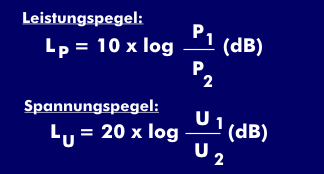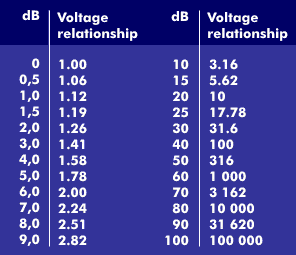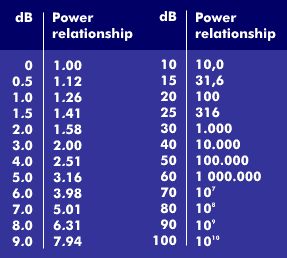decibel (dB)
Decibel (dB) is the logarithmized ratio of two electrical quantities(voltage, current, power). The Bel was named after the Scottish inventor Alexander Graham Bell (1847-1922), who also invented the telephone. The unit Bel corresponds to the signal attenuation in a telephone wire over a length of one mile. Originally, this dimensionless unit was used to compare the powers at the input and output of a transmission medium. The decibel is one-tenth of a Bel; although the base unit Bel is not used.
The decibel can be relative and also absolute. As a relative ratio, it refers to voltages and powers. For voltages, it is 20 times the logarithm of the voltage ratio between output to input voltage; relative dB power values are calculated using 10 times the logarithm of the power ratios between output to input power.
The logarithmic representation
The advantage of this logarithmic representation is that powers of ten can be represented relatively easily and need only be added or subtracted in calculations. For example, a voltage ratio of 1:10 corresponds to a dB value of 20 dB, and a ratio of 1:100 corresponds to a dB value of 40 dB. A power ratio of 1:10 corresponds to a dB value of 10 dB, and one of 1:100 corresponds to a dB value of 20 dB.
A power increase of 3 dB corresponds to a doubling of power; a power reduction(attenuation) of -3 dB corresponds to a halving of power. In order to be able to determine an absolute power value, a reference value was defined and this was designated as dBm. 0 dBm corresponds to an effective power of 1 mW at 600 ohms.
Since oscillation widths(amplitudes), i.e. voltages, tend to play a role in communications technology, the attenuation ratio is defined as the logarithmic ratio of the input voltage to the output voltage. A difference of 6 dB between input and output corresponds to an amplitude drop to half, 20 dB to one tenth. So that the absolute voltage value can also be determined, two reference values have been defined: the dBV and the dBu. The former refers to an effective voltage of 1 V, the latter to 0.7746 V at 600 ohms, corresponding to 1 mW.
The great advantage of the dB calculation is that when several lines or quadrupoles are connected in series, the dB values for the attenuations and gains simply have to be added or subtracted.



